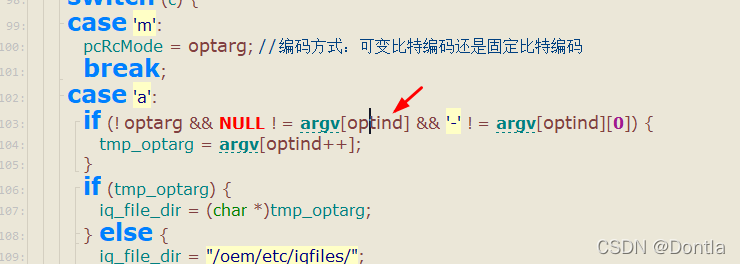C语言linux getopt_long()函数(命令行解析)(getopt、getopt_long_only)(短选项 -,长选项 --)(option结构体)(optind、optarg变量)
参考文章:浅谈linux的命令行解析参数之getopt_long函数文章目录前言一、关于命令行参数二、getopt_long函数参数以及返回值介绍(以上三个函数都适用):1、argc和argv和main函数的两个参数一致。2、optstring: 表示短选项字符串。3、longopts:表示长选项结构体。结构如下:4、longindex:longindex非空,它指向的变量将记录当前找到参数符合l
参考文章:浅谈linux的命令行解析参数之getopt_long函数
文章目录
前言
在linux中,经常需要各种命令,通常情况下都会带各种参数,而这些参数是如何解析的呢?通常使用GNU C提供的函数getopt、getopt_long、getopt_long_only函数来解析命令行参数。
一、关于命令行参数
命令行参数可以分为两类,一类是短选项,一类是长选项,短选项在参数前加一杠"-",长选项在参数前连续加两杠"–",如下表(ls 命令参数)所示,其中-a,-A,-b都表示短选项,–all,–almost-all, --author都表示长选项。他们两者后面都可选择性添加额外参数。比如–block-size=SIZE,SIZE便是额外的参数。例如:
LS(1) User Commands LS(1)
NAME
ls - list directory contents
SYNOPSIS
ls [OPTION]... [FILE]...
DESCRIPTION
List information about the FILEs (the current directory by default).
Sort entries alphabetically if none of -cftuvSUX nor --sort is speci‐
fied.
Mandatory arguments to long options are mandatory for short options
too.
-a, --all
do not ignore entries starting with .
-A, --almost-all
do not list implied . and ..
--author
with -l, print the author of each file
-b, --escape
print C-style escapes for nongraphic characters
--block-size=SIZE
scale sizes by SIZE before printing them; e.g., '--block-size=M'
prints sizes in units of 1,048,576 bytes; see SIZE format below
-B, --ignore-backups
do not list implied entries ending with ~
二、getopt_long函数
getopt函数只能处理短选项,而getopt_long函数两者都可以,可以说getopt_long已经包含了getopt的功能。因此,这里就只介绍getopt_long函数。而getopt_long与getopt_long_only的区别很小,等介绍完getopt_long,再提起会更好。
#include <unistd.h>
extern char *optarg;
extern int optind, opterr, optopt;
#include <getopt.h>
int getopt(int argc, char * const argv[],const char *optstring);
int getopt_long(int argc, char * const argv[], const char *optstring, const struct option *longopts, int *longindex);
int getopt_long_only(int argc, char * const argv[], const char *optstring, const struct option *longopts, int *longindex);
参数以及返回值介绍(以上三个函数都适用):
1、argc和argv和main函数的两个参数一致。
2、optstring: 表示短选项字符串。
形式如“a:b::cd:“,分别表示程序支持的命令行短选项有-a、-b、-c、-d,冒号含义如下:
(1)只有一个字符,不带冒号——只表示选项, 如-c
(2)一个字符,后接一个冒号——表示选项后面带一个参数,如-a 100
(3)一个字符,后接两个冒号——表示选项后面带一个可选参数,即参数可有可无, 如果带参数,则选项与参数之间不能有空格
形式应该如-b200
3、longopts:表示长选项结构体。结构如下:
struct option
{
const char *name;
int has_arg;
int *flag;
int val;
};
eg:
static struct option longOpts[] = {
{ "daemon", no_argument, NULL, 'D' },
{ "dir", required_argument, NULL, 'd' },
{ "out", required_argument, NULL, 'o' },
{ "log", required_argument, NULL, 'l' },
{ "split", required_argument, NULL, 's' },
{ "http-proxy", required_argument, &lopt, 1 },
{ "http-user", required_argument, &lopt, 2 },
{ "http-passwd", required_argument, &lopt, 3 },
{ "http-proxy-user", required_argument, &lopt, 4 },
{ "http-proxy-passwd", required_argument, &lopt, 5 },
{ "http-auth-scheme", required_argument, &lopt, 6 },
{ "version", no_argument, NULL, 'v' },
{ "help", no_argument, NULL, 'h' },
{ 0, 0, 0, 0 }
};
(1)name:表示选项的名称,比如daemon,dir,out等。
(2)has_arg:表示选项后面是否携带参数。该参数有三个不同值,如下:
a: no_argument(或者是0)时 ——参数后面不跟参数值,eg: --version,--help
b: required_argument(或者是1)时 ——参数输入格式为:--参数 值 或者 --参数=值。eg:--dir=/home
c: optional_argument(或者是2)时 ——参数输入格式只能为:--参数=值
(3)flag:这个参数有两个意思,空或者非空。
a:如果参数为空NULL,那么当选中某个长选项的时候,getopt_long将返回val值。
eg,可执行程序 --help,getopt_long的返回值为h.
b:如果参数不为空,那么当选中某个长选项的时候,getopt_long将返回0,并且将flag指针参数指向val值。
eg: 可执行程序 --http-proxy=127.0.0.1:80 那么getopt_long返回值为0,并且lopt值为1。
(4)val:表示指定函数找到该选项时的返回值,或者当flag非空时指定flag指向的数据的值val。
4、longindex:longindex非空,它指向的变量将记录当前找到参数符合longopts里的第几个元素的描述,即是longopts的下标值。
5、全局变量:
(1)optarg:表示当前选项对应的参数值。
(2)optind:表示的是下一个将被处理到的参数在argv中的下标值。
(3)opterr:如果opterr = 0,在getopt、getopt_long、getopt_long_only遇到错误将不会输出错误信息到标准输出流。opterr在非0时,向屏幕输出错误。
(4)optopt:表示没有被未标识的选项。
6、返回值:
(1)如果短选项找到,那么将返回短选项对应的字符。
(2)如果长选项找到,如果flag为NULL,返回val。如果flag不为空,返回0
(3)如果遇到一个选项没有在短字符、长字符里面。或者在长字符里面存在二义性的,返回“?”
(4)如果解析完所有字符没有找到(一般是输入命令参数格式错误,eg: 连斜杠都没有加的选项),返回“-1”
(5)如果选项需要参数,忘了添加参数。返回值取决于optstring,如果其第一个字符是“:”,则返回“:”,否则返回“?”。
注意:
(1)longopts的最后一个元素必须是全0填充,否则会报段错误
(2)短选项中每个选项都是唯一的。而长选项如果简写,也需要保持唯一性。
三、测试(自行测试)(getopts配合case来进行操作时有两个隐含变量:一个是OPTARG,用来取当前选项的值,另外一个是OPTIND,代表下一个要处理的元素位置。)
1、官网给出测试用例。
#include <stdio.h> /* for printf */
#include <stdlib.h> /* for exit */
#include <getopt.h>
int main(int argc, char **argv)
{
int c;
int digit_optind = 0;
while (1) {
int this_option_optind = optind ? optind : 1;
int option_index = 0;
static struct option long_options[] = {
{"add", required_argument, 0, 0 },
{"append", no_argument, 0, 0 },
{"delete", required_argument, 0, 0 },
{"verbose", no_argument, 0, 0 },
{"create", required_argument, 0, 'c'},
{"file", required_argument, 0, 0 },
{0, 0, 0, 0 }
};
c = getopt_long(argc, argv, "abc:d:012",
long_options, &option_index);
if (c == -1)
break;
switch (c) {
case 0:
printf("option %s", long_options[option_index].name);
if (optarg)
printf(" with arg %s", optarg);
printf("\n");
break;
case '0':
case '1':
case '2':
if (digit_optind != 0 && digit_optind != this_option_optind)
printf("digits occur in two different argv-elements.\n");
digit_optind = this_option_optind;
printf("option %c\n", c);
break;
case 'a':
printf("option a\n");
break;
case 'b':
printf("option b\n");
break;
case 'c':
printf("option c with value '%s'\n", optarg);
break;
case 'd':
printf("option d with value '%s'\n", optarg);
break;
case '?':
break;
default:
printf("?? getopt returned character code 0%o ??\n", c);
}
}
if (optind < argc) {
printf("non-option ARGV-elements: ");
while (optind < argc)
printf("%s ", argv[optind++]);
printf("\n");
}
exit(EXIT_SUCCESS);
}
运行结果:
[root@ubuntu /home/yg/arnold_test/20211129_TEST_getopt]23# ./a.out -0
option 0
[root@ubuntu /home/yg/arnold_test/20211129_TEST_getopt]24# ./a.out -1
option 1
[root@ubuntu /home/yg/arnold_test/20211129_TEST_getopt]25# ./a.out -2
option 2
[root@ubuntu /home/yg/arnold_test/20211129_TEST_getopt]26# ./a.out -a
option a
[root@ubuntu /home/yg/arnold_test/20211129_TEST_getopt]27# ./a.out -b
option b
[root@ubuntu /home/yg/arnold_test/20211129_TEST_getopt]28#
[root@ubuntu /home/yg/arnold_test/20211129_TEST_getopt]28# ./a.out -c100
option c with value '100'
[root@ubuntu /home/yg/arnold_test/20211129_TEST_getopt]29# ./a.out -d333
option d with value '333'
还是有点懵逼,先用着吧!!
20211230 optind变量
今天看\external\rkmedia\examples\rkmedia_venc_mjpeg_test.c源码,有个optind变量,不知道在哪定义的,点又点不进去

解释:
1.这个变量是在什么地方定义的?
答:系统定义的
2.这个变量在什么场景下使用?
答:在解析命令行参数时会用到
3.这个变量存在的意义?
在每调用一次getopt()或getopt_long()类似函数时此值会递增1
参考文章:optind变量
更多推荐
 已为社区贡献175条内容
已为社区贡献175条内容









所有评论(0)